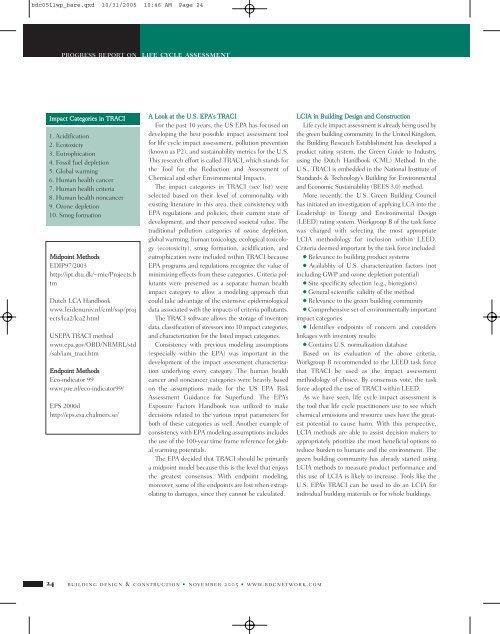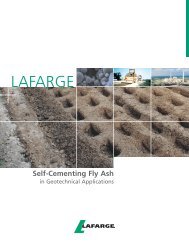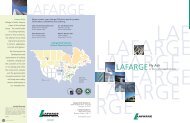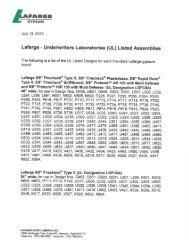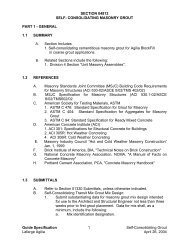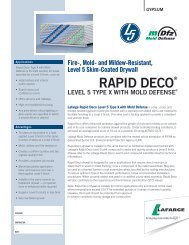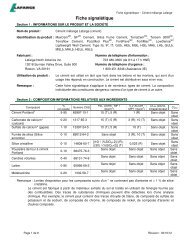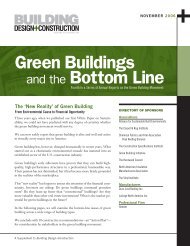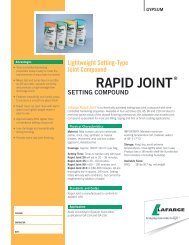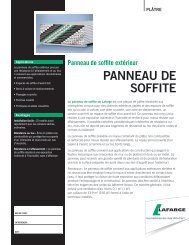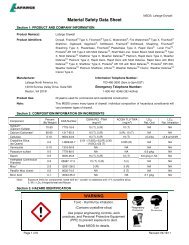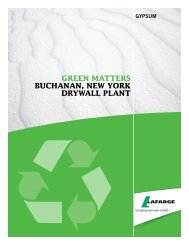Life Cycle Assessment and Sustainability
2005, "Life Cycle Assessment and Sustainability" - Lafarge
2005, "Life Cycle Assessment and Sustainability" - Lafarge
You also want an ePaper? Increase the reach of your titles
YUMPU automatically turns print PDFs into web optimized ePapers that Google loves.
dc0511wp_bare.qxd 10/31/2005 10:46 AM Page 24progress report on life cycle assessmentImpact Categories in TRACI1. Acidification2. Ecotoxicty3. Eutrophication4. Fossil fuel depletion5. Global warming6. Human health cancer7. Human health criteria8. Human health noncancer9. Ozone depletion10. Smog formationMidpoint MethodsEDIP97/2003http://ipt.dtu.dk/~mic/Projects.htmDutch LCA H<strong>and</strong>bookwww.leidenuniv.nl/cml/ssp/projects/lca2/lca2.htmlUSEPA TRACI methodwww.epa.gov/ORD/NRMRL/std/sab/iam_traci.htmEndpoint MethodsEco-indicator 99www.pre.nl/eco-indicator99/EPS 2000dhttp://eps.esa.chalmers.se/A Look at the U.S. EPA’s TRACIFor the past 10 years, the US EPA has focused ondeveloping the best possible impact assessment toolfor life cycle impact assessment, pollution prevention(known as P2), <strong>and</strong> sustainability metrics for the U.S.This research effort is called TRACI, which st<strong>and</strong>s forthe Tool for the Reduction <strong>and</strong> <strong>Assessment</strong> ofChemical <strong>and</strong> other Environmental Impacts.The impact categories in TRACI (see list) wereselected based on their level of commonality withexisting literature in this area, their consistency withEPA regulations <strong>and</strong> policies, their current state ofdevelopment, <strong>and</strong> their perceived societal value. Thetraditional pollution categories of ozone depletion,global warming, human toxicology, ecological toxicology(ecotoxicity), smog formation, acidification, <strong>and</strong>eutrophication were included within TRACI becauseEPA programs <strong>and</strong> regulations recognize the value ofminimizing effects from these categories. Criteria pollutantswere preserved as a separate human healthimpact category to allow a modeling approach thatcould take advantage of the extensive epidemiologicaldata associated with the impacts of criteria pollutants.The TRACI software allows the storage of inventorydata, classification of stressors into 10 impact categories,<strong>and</strong> characterization for the listed impact categories.Consistency with previous modeling assumptions(especially within the EPA) was important in thedevelopment of the impact assessment characterizationunderlying every category. The human healthcancer <strong>and</strong> noncancer categories were heavily basedon the assumptions made for the US EPA Risk<strong>Assessment</strong> Guidance for Superfund. The EPA’sExposure Factors H<strong>and</strong>book was utilized to makedecisions related to the various input parameters forboth of these categories as well. Another example ofconsistency with EPA modeling assumptions includesthe use of the 100-year time frame reference for globalwarming potentials.The EPA decided that TRACI should be primarilya midpoint model because this is the level that enjoysthe greatest consensus. With endpoint modeling,moreover, some of the endpoints are lost when extrapolatingto damages, since they cannot be calculated.LCIA in Building Design <strong>and</strong> Construction<strong>Life</strong> cycle impact assessment is already being used bythe green building community. In the United Kingdom,the Building Research Establishment has developed aproduct rating system, the Green Guide to Industry,using the Dutch H<strong>and</strong>book (CML) Method. In theU.S., TRACI is embedded in the National Institute ofSt<strong>and</strong>ards & Technology’s Building for Environmental<strong>and</strong> Economic <strong>Sustainability</strong> (BEES 3.0) method.More recently, the U.S. Green Building Councilhas initiated an investigation of applying LCA into theLeadership in Energy <strong>and</strong> Environmental Design(LEED) rating system. Workgroup B of the task forcewas charged with selecting the most appropriateLCIA methodology for inclusion within LEED.Criteria deemed important by the task force included:● Relevance to building product systems● Availablity of U.S. characterization factors (notincluding GWP <strong>and</strong> ozone depletion potential)● Site specificity selection (e.g., bioregions)● General scientific validity of the method● Relevance to the green building community● Comprehensive set of environmentally importantimpact categories● Identifies endpoints of concern <strong>and</strong> considerslinkages with inventory results● Contains U.S. normalization databaseBased on its evaluation of the above criteria,Workgroup B recommended to the LEED task forcethat TRACI be used as the impact assessmentmethodology of choice. By consensus vote, the taskforce adopted the use of TRACI within LEED.As we have seen, life cycle impact assessment isthe tool that life cycle practitioners use to see whichchemical emissions <strong>and</strong> resource uses have the greatestpotential to cause harm. With this perspective,LCIA methods are able to assist decision makers toappropriately prioritize the most beneficial options toreduce burden to humans <strong>and</strong> the environment. Thegreen building community has already started usingLCIA methods to measure product performance <strong>and</strong>this use of LCIA is likely to increase. Tools like theU.S. EPA’s TRACI can be used to do an LCIA forindividual building materials or for whole buildings.24 building design & construction ▪ november 2005 ▪ www.bdcnetwork.com


